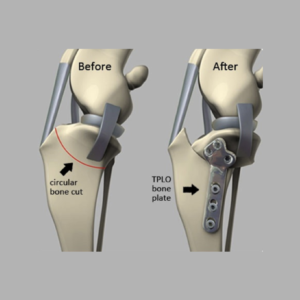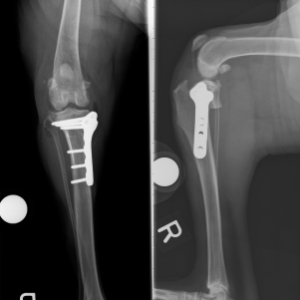TPLO Repair for a CCL Injury
Tibial Plateau Leveling Osteotomy Surgery is used to provide stability for dogs with a cranial cruciate ligament injury.
Reliable Technique
As one of the original osteotomy techniques, it aims to reduce the Tibial Plateau Angle. By changing the TPA, when a dog bears weight the forces acting on the joint are neutralized. In a dog with CCL injury, neutralizing the forces eliminates the thrust of the tibia in relation to the femur. This technique alters the biomechanics of the joint and eliminates the need for the CCL.
Surgery Process
TPLO surgery involves making a cut in the bone, called an osteotomy, and rotating the cut piece of bone to reduce the TPA. The cut bone is then stabilized with a bone plate and screws. Once the bone has healed, the plate and screws are no longer necessary. They're typically left in place unless there is a problem associated with the plate such as infection or irritation.
Recovery
Dogs are usually comfortable fairly quickly after successful TPLO surgery and may begin putting weight on the affected limb within days. With TPLO, there is a reported 90-95% good to excellent outcome. This means your pet can run, jump and play AFTER full recovery, at least 8 weeks post-op.
90%-95% good to excellent surgical outcome especially in large breed, active dogs.


General
Surgery Risks
- General Anesthetic Risks
- Life-Threatening Cardiorespiratory Arrest
- Incisional Breakdown & Separation
- Incision Infection
- Incisional Swelling (Seroma)
- Bleeding
Complications
& Risks
- Delayed Bone Healing or Non-Healing Bone
- Malunion Bone Healing (Mal-Alignment)
- Implant Failure
- Implant or Bone Infection (Osteomyelitis)
- Bone Fracture
- Subsequent Meniscal Injury
- Patellar Ligament Desmitis (Inflammation)
- Patellar Luxation
- Pivot Shift
- Risk Contralateral Cranial Cruciate Ligament Rupture Within 1-2 Years

